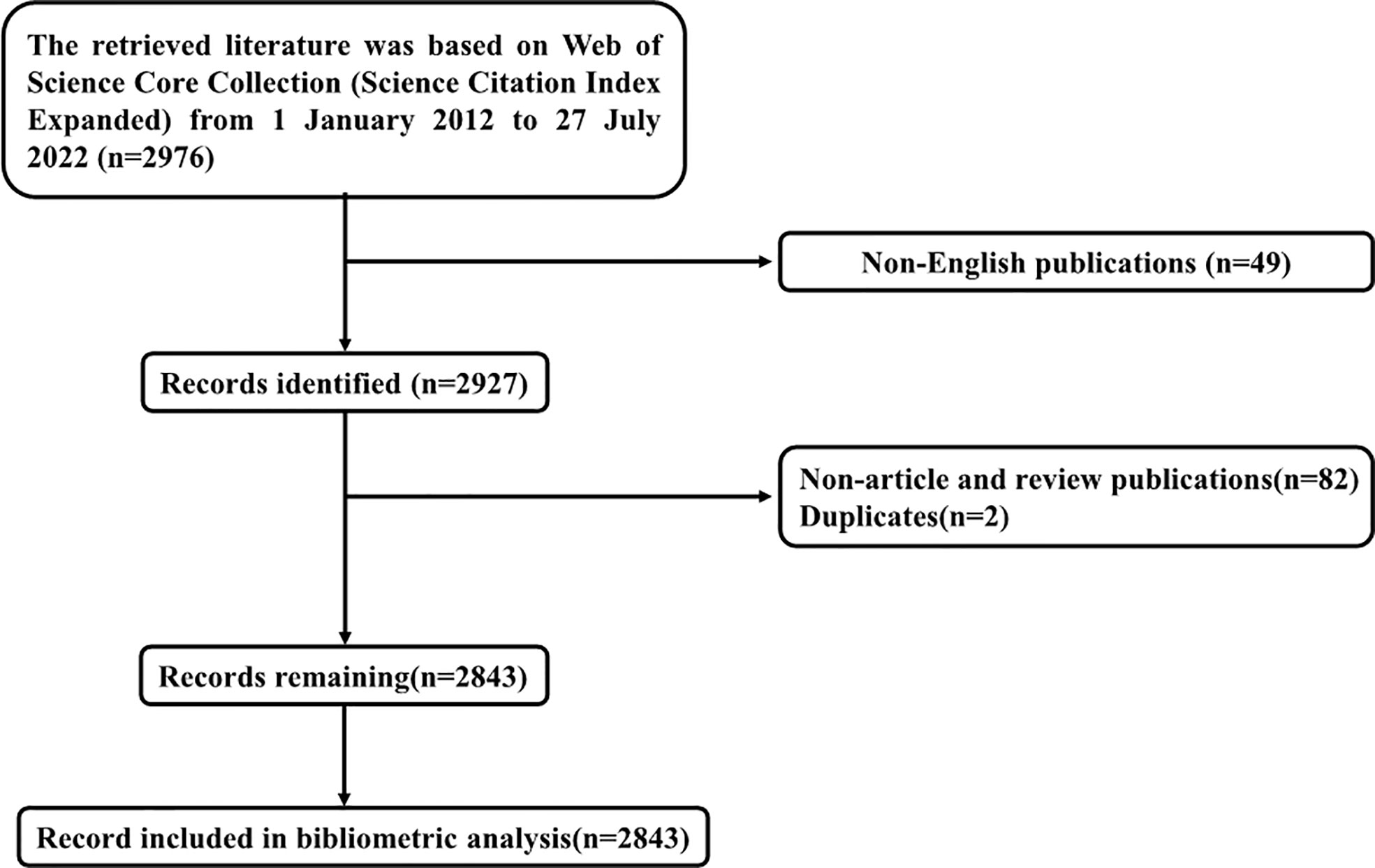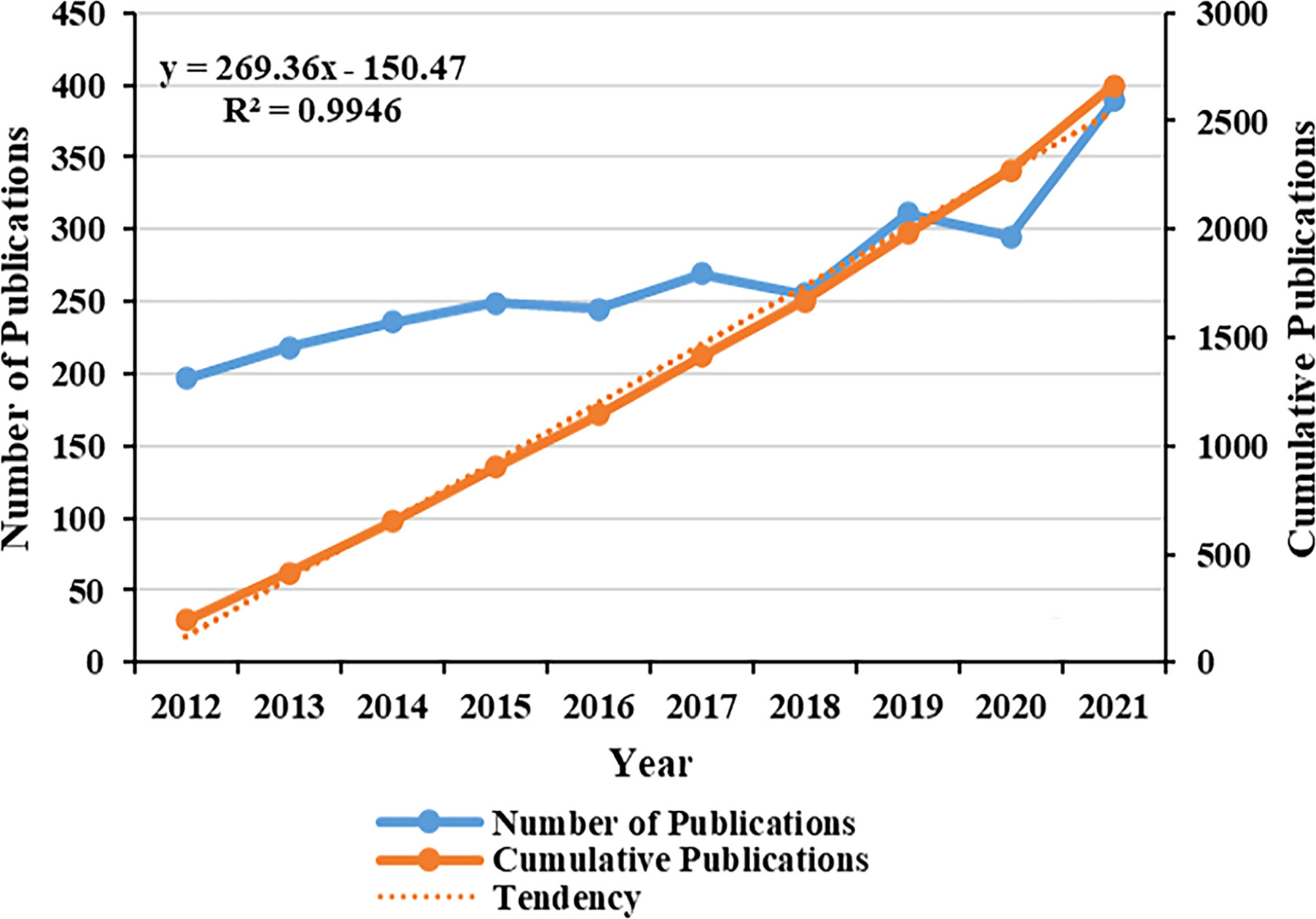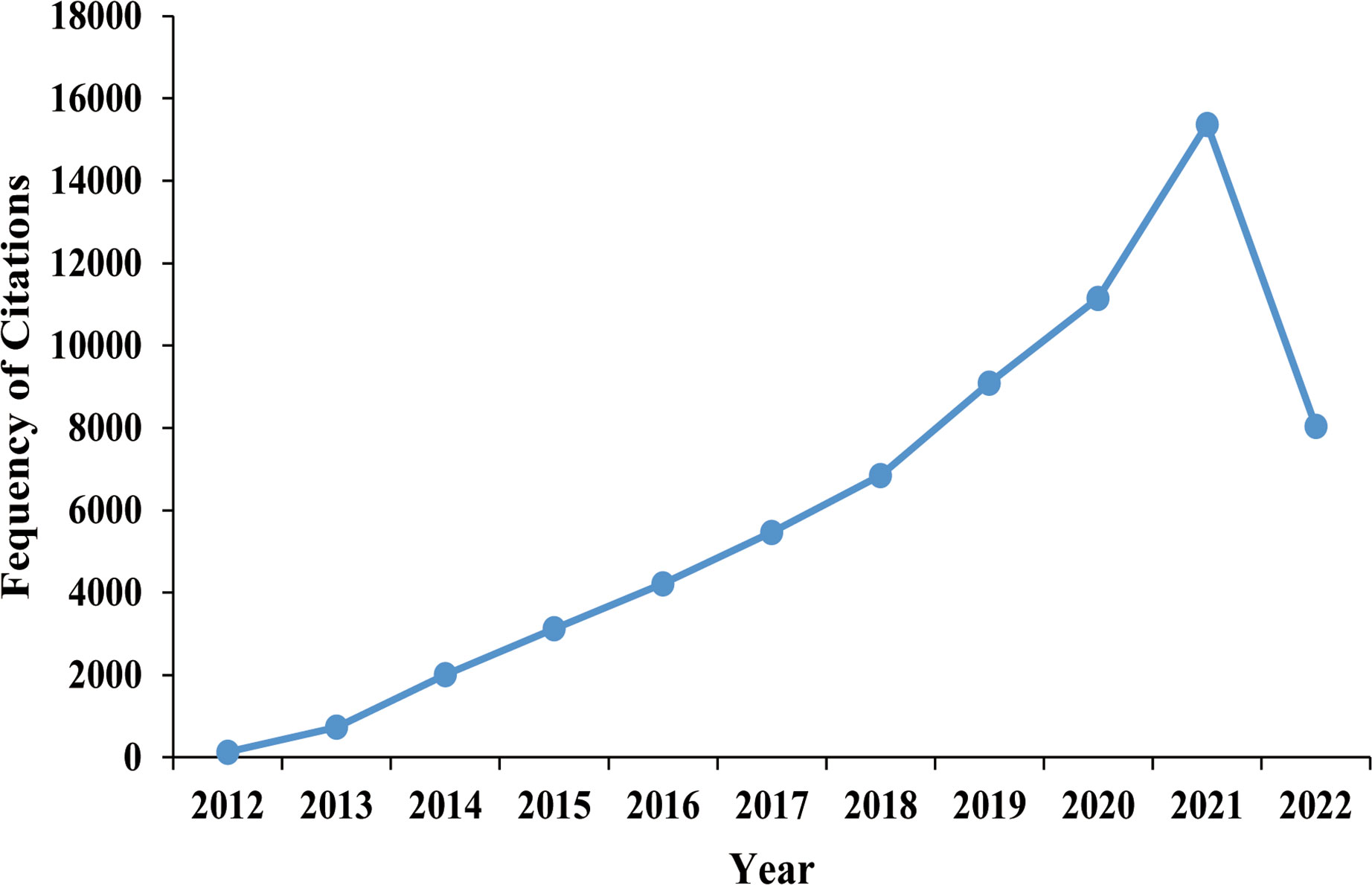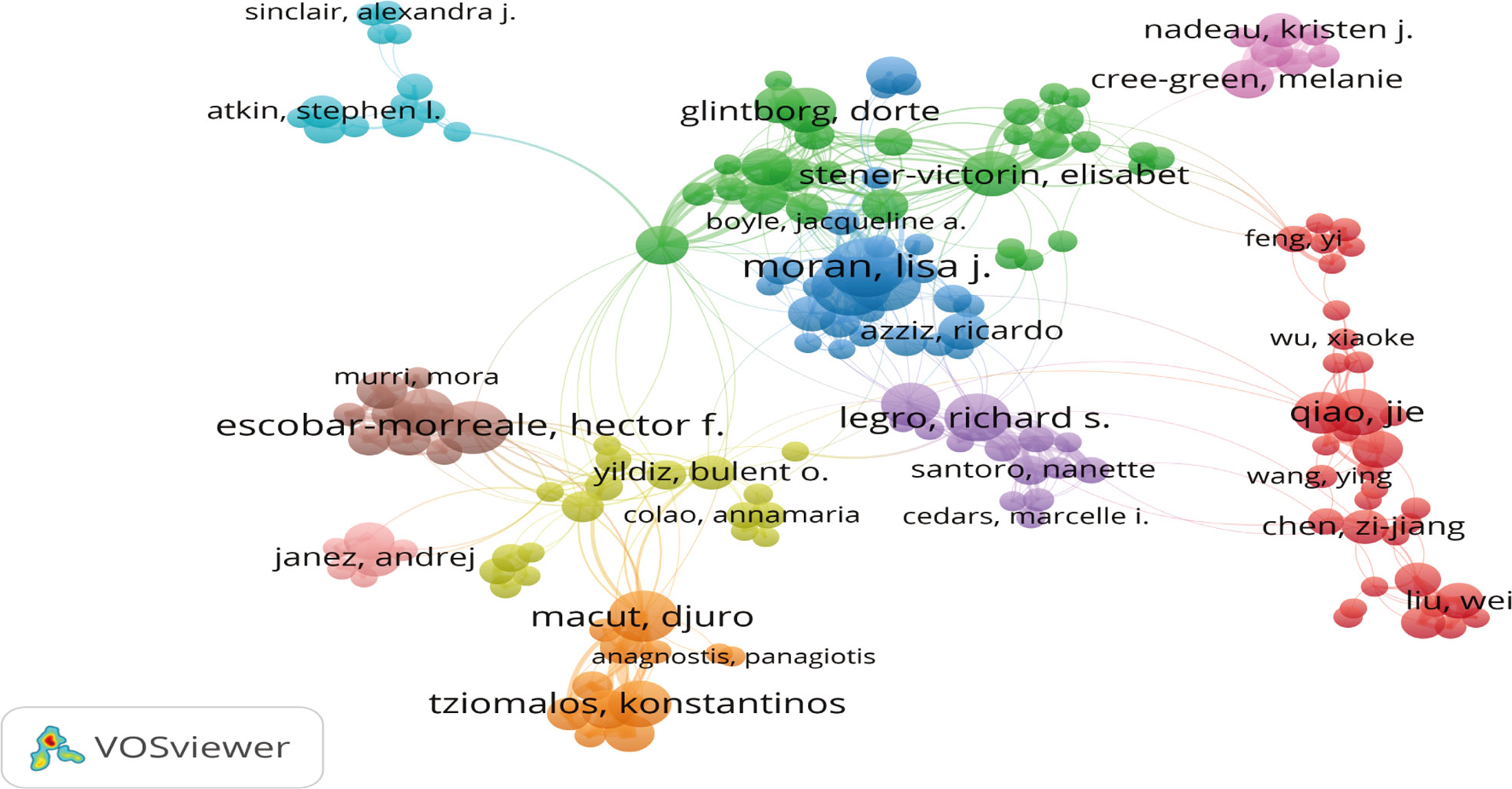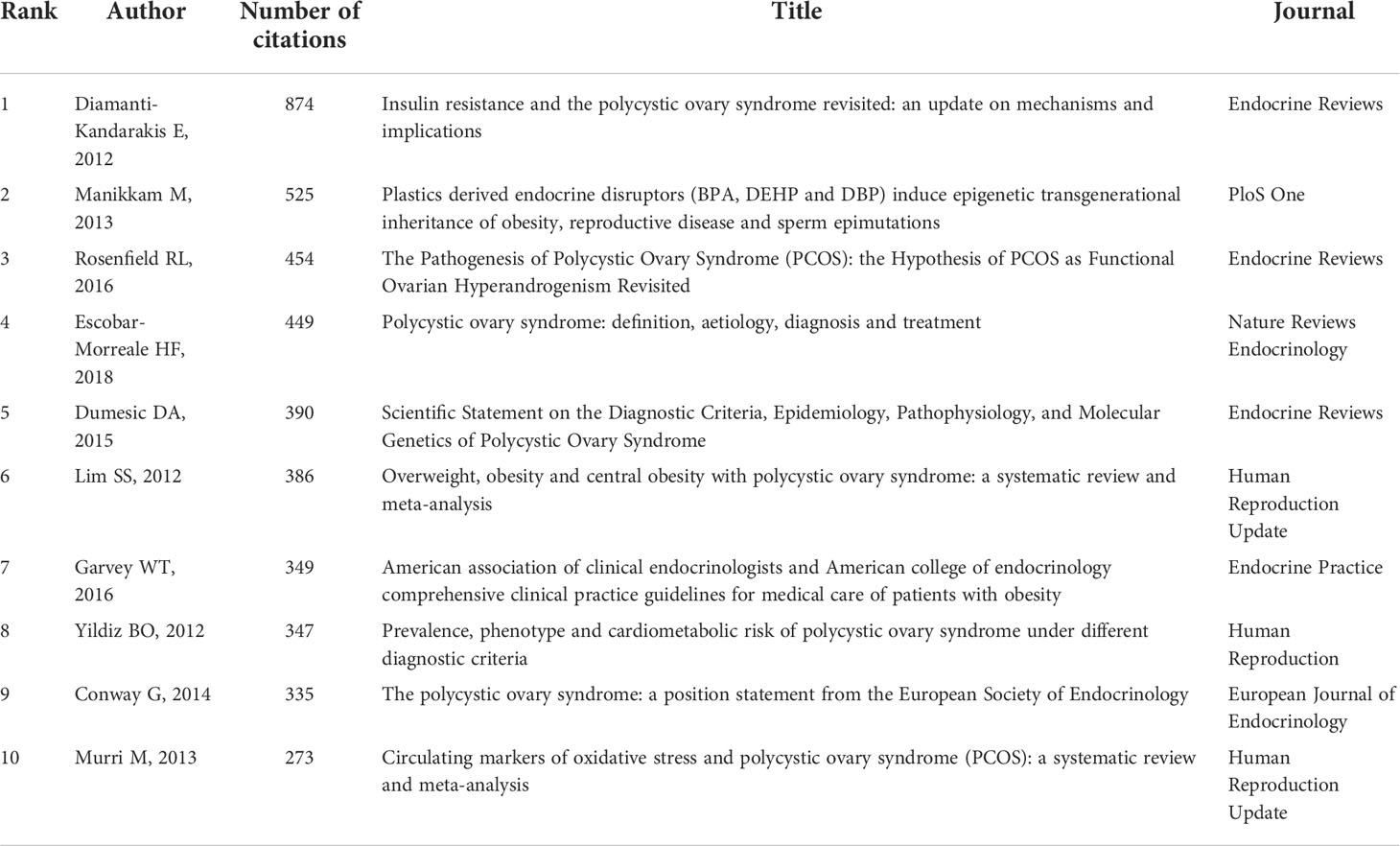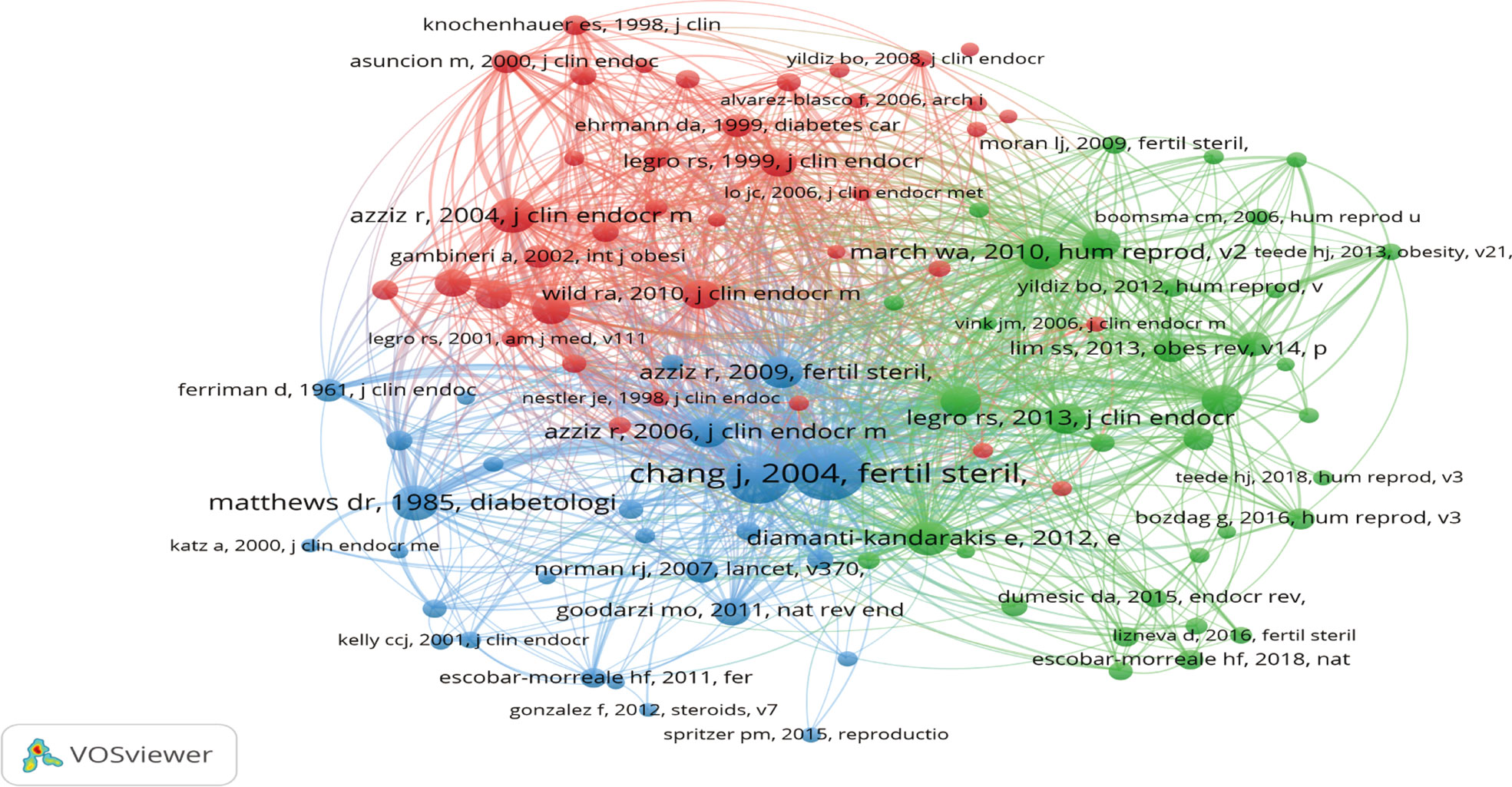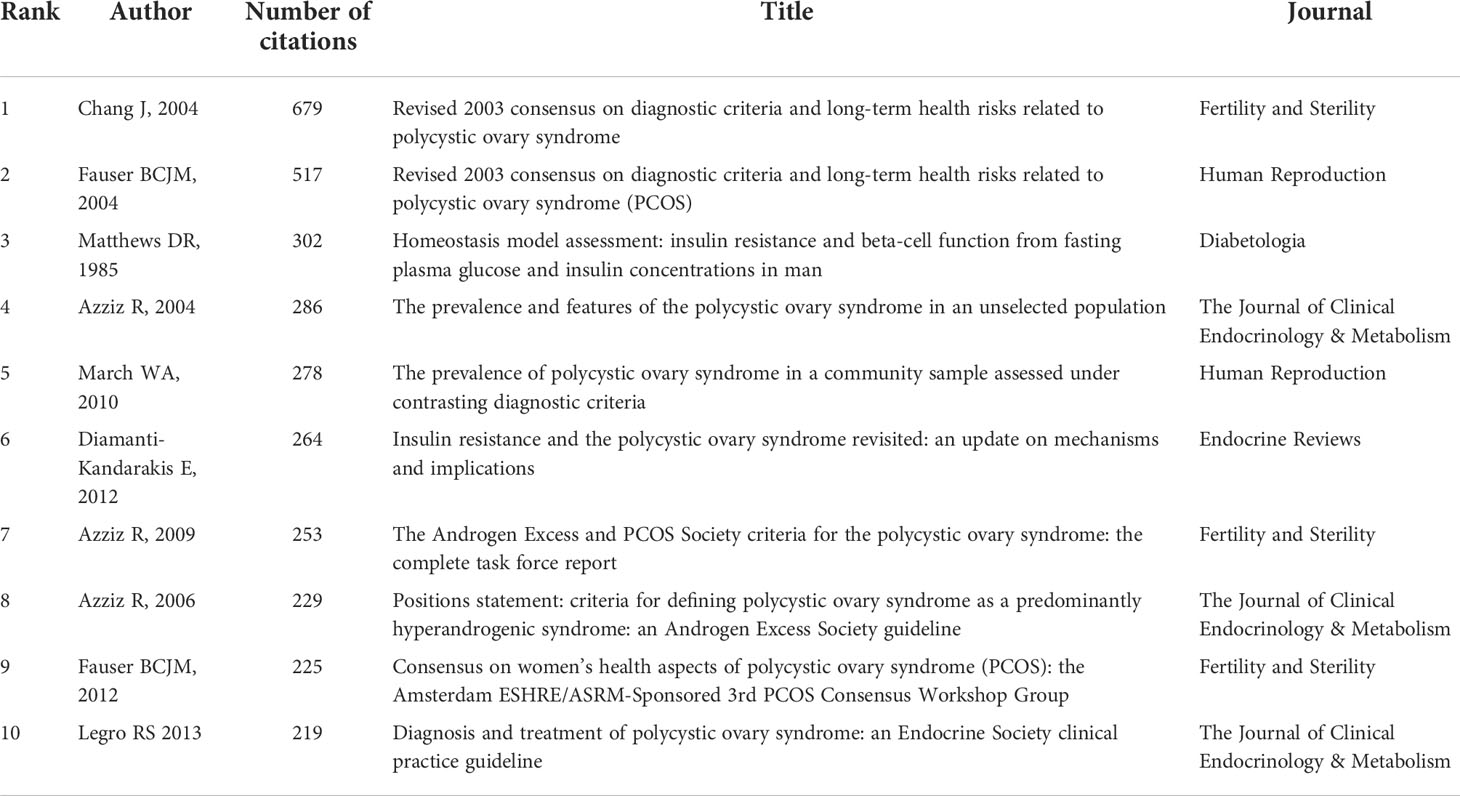- Department of General Surgery, Third Xiangya Hospital, Central South University, Changsha, Hunan, China
Background: Obesity is associated with polycystic ovary syndrome (PCOS). We aimed to elucidate the research status and explore research trends and future directions of research on obesity and PCOS.
Methods: A bibliometric analysis of the published papers in the field of obesity and PCOS between 2012 and 2022 was conducted on the basis of the Web of Science Core Collection database. The collaboration networks, research trends, literature sources, citation analysis, co-citation analysis, and keywords analysis were statistically analyzed and visualized using the VOSviewer software.
Results: We retrieved 2843 records from 681 journals by 12307 authors from 2942 institutes in 99 countries. The number of published papers and citations had a roughly increasing trend annually. The United States and China contributed the majority of the records. Monash University, Shanghai Jiaotong University, Aristotle University of Thessaloniki, Karolinska Institute, University of São Paulo, and Tehran University of Medical Sciences were the biggest nodes in their cluster of the collaboration network map, and Moran LJ, Teede HJ, Joham AE, Escobar-Morreale HF, and Macut D were prolific authors. Research trends and hotspots were identified and visualized in the field of obesity and PCOS. Research hotspots in this field focused on insulin resistance (IR), metabolic syndrome, metformin, and inflammation. Bariatric surgery, mitochondrial dysfunction, binding globulins, and comorbidities may be the frontiers of future research.
Conclusions: We concluded the research status and trends in the field of obesity and PCOS. A better understanding of collaboration patterns, research hotspots, and frontiers may be useful for researchers.
1 Introduction
Obesity, defined as abnormal or excessive fat accumulation that may impair health, is a worldwide pandemic disease, especially in women (1, 2). Obesity increases the risk of multiple diseases, such as diabetes mellitus (3), cardiovascular disease (3, 4), and PCOS (5). PCOS, characterized by ovulatory dysfunction, hyperandrogenism, and polycystic ovaries, is one of the most common heterogeneous endocrine conditions and affected 5% to 10% of reproductive-age women, depending on the Rotterdam criteria (6, 7). Approximately 50% of women with PCOS are overweight or obese (8). Although the etiology of PCOS remains unclear, IR and hyperandrogenemia (HA) play a major role in the pathogenesis of PCOS development and complications (9). However, obesity is strongly associated with IR and HA. Obesity amplifies and worsens the adverse metabolic and reproductive outcomes of PCOS and increases IR and compensatory hyperinsulinemia and generates testosterone while suppressing gonadotropin production (10). Meanwhile, Obesity sensitizes thecal cells to luteinizing hormone stimulation and amplifies HA by upregulating ovarian androgen levels (11). The symptoms of PCOS can be improved with weight loss through lifestyle modification, excise, drug therapy, and bariatric surgery (12). However, the pathophysiologic mechanism and intricate relationship between obesity and PCOS remain uncertain, numerous studies have been conducted to identify the question (13–15).
Based on this, it is necessary for us to learn about the advances and novel trends in this field. Bibliometric analysis, an approach to quantifying and visualizing published documents, can provide an overview of the current research status and establish future research orientations in a specialized field (16). Bibliometric analysis revealed the research characteristics, status, and trends of PCOS in specific times and regions (17, 18). Some studies also have explored the research status, hotspots, and trends of research between PCOS and infertility as well as IR by the method of bibliometrics (19, 20). To the best of our knowledge, no bibliometric analysis has focused on the collaboration patterns and research trends, and hotspots of research on obesity and PCOS. To clarify the current research status and provide references for future research, we performed a bibliometric analysis to quantify and visualize this research field through analysis of the information in published papers.
2 Materials and methods
2.1 Literature source and retrieval
The retrieved documents were based on the Web of Science Core Collection (Science Citation Index Expanded, SCI-E) from 1 January 2012 to 27 July 2022. The detailed retrieval strategy was as follows: TS= (“Polycystic Ovary Syndrome” OR “Polycystic Ovarian Syndrome” OR “Stein-Leventhal Syndrome”) AND TS= (“obesity”). The document type was limited to articles and reviews. Only publications in English were included.
2.2 Inclusion and exclusion criteria
Inclusion criteria were peer-reviewed published original articles or reviews about obesity and PCOS. Exclusion criteria were: 1) Early access, meeting abstract, editorial material, and other types; 2) repeated publications.
2.3 Literature analysis methods
All the records were downloaded as plain text and imported to VOSviewer to conduct bibliometric analysis. Corresponding data statistics and analysis were used by Excel 2019 (Microsoft) and GraphPad Prism (version 8.0). VOSviewer (version 1.6.18, Leiden University) was an available software for creating and viewing bibliometric maps and was used for visualizing the collaborations between countries, institutions, authors, keywords, and references (21). Each node represents an individual, the same color represents the same cluster, the size of the circles means the number or frequency of individuals, and the lines between circles express the intensity of cooperation (22).
3 Results
3.1 Search results
Totally 2976 publications were identified from SCI-E. Duplicates, non-article and review publications, and non-English publications were excluded. Finally, 2843 was identified as the number of published records and included in the final bibliometric analysis (Figure 1).
3.2 General trends and annual publications
Papers, published over the past 10 years, roughly conformed to the increasing trend year by year, and the cumulative number of published articles showed an overall upward trend (Figure 2). Most records were original articles and reviews (2843/2927, 97.1%), which can greatly reflect the development trends and changes in the field of obesity and PCOS. Through database searching, the 2843 documents were cited 66178 times, with an average of 23.3 times per paper, and an H-index of 101 (Figure 3). It can be seen that the direction of obesity and PCOS has attracted more and more researchers’ attention.
3.3 Countries and districts
Ninety-nine countries contributed to publications in the field of obesity and PCOS worldwide. The top 3 countries that published papers were the United States, China, and Turkey, accounting for 47.7% (1356/2843). Australia had the highest average number of citations (38.9), followed by the United Kingdom (38.4), the United States (37.2), Italy (35.6), and Turkey (15.4) (Table 1).
The top 30 most prolific countries had formed 3 stable clusters and created a network map. There was active cooperation between these countries, especially between the United States and China (Figure 4A). Viewed from the dynamics and trends, research about obesity and PCOS mainly focused on the United States, Greece, Australia, and Turkey from 2012 to 2017. The field and direction gradually received greater attention from other countries after 2017 (Figure 4B).
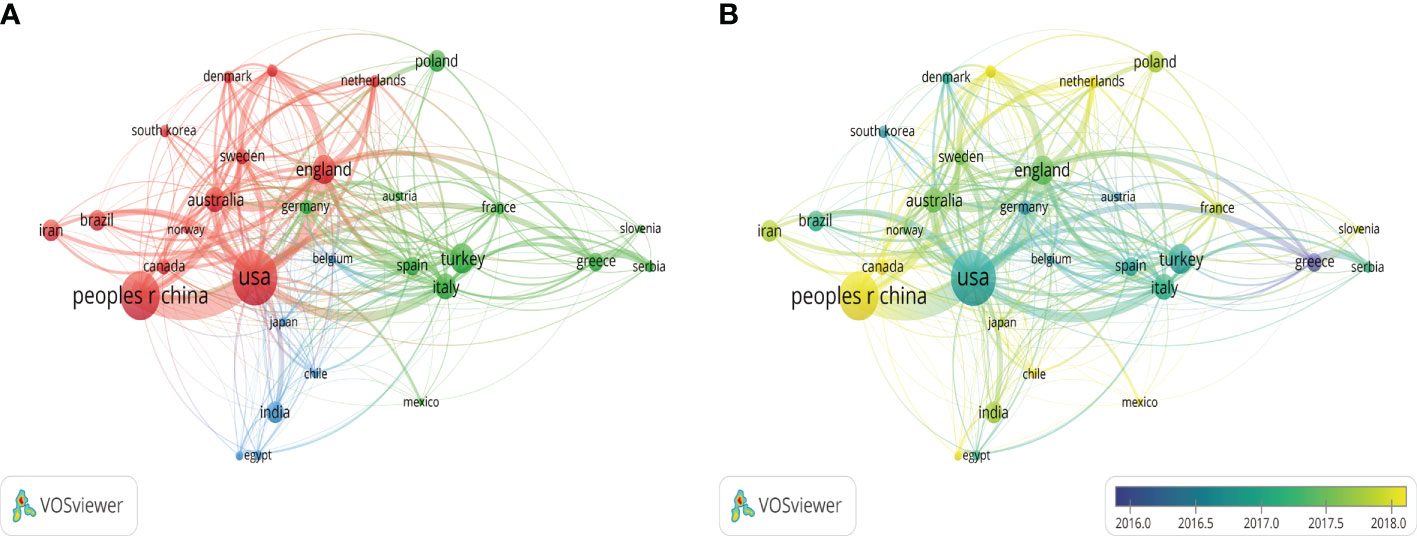
Figure 4 Visualization map of countries and districts. (A) Network diagram of the top 30 countries/districts. (B) Dynamics and trends of the top 30 countries/districts.
3.4 Universities and institutions
A total of 2942 institutions were involved in these documents. Collaborative network analyses have been conducted between universities or institutions. In a network and overlay visualization of institutions in the top 100, 6 clusters were formed and the biggest node represented that the institution published the most article in their cluster (Figure 5A). Monash University (n=88, 3.1%, Cluster 6), Shanghai Jiaotong University (n=57, 2.0%, Cluster 3), Aristotle University of Thessaloniki (n=41, 1.4%, Cluster 2), Karolinska Institute (n=40, 1.4%, Cluster 4), University of São Paulo (n=38, 1.3%, Cluster 1), and Tehran University of Medical Sciences (n=32, 1.1%, Cluster 5) were the biggest nodes in their cluster, Cluster 1 was the biggest cluster, which contained 40 nodes that represented its related different universities or institutions, while Cluster 6 was the smallest, which included 4 nodes. The other clusters included 20 nodes (Cluster 2), 19 nodes (Cluster 3), and 12 nodes (Cluster 4). Furthermore, the results showed that 3 universities mainly contributed to this field from 2012 to 2017, which included Aristotle University of Thessaloniki, The University of Adelaide, and University of São Paulo. Since then, these studies have gradually gained popularity among other institutes, such as Monash University, and Shanghai Jiaotong University (Figure 5B).
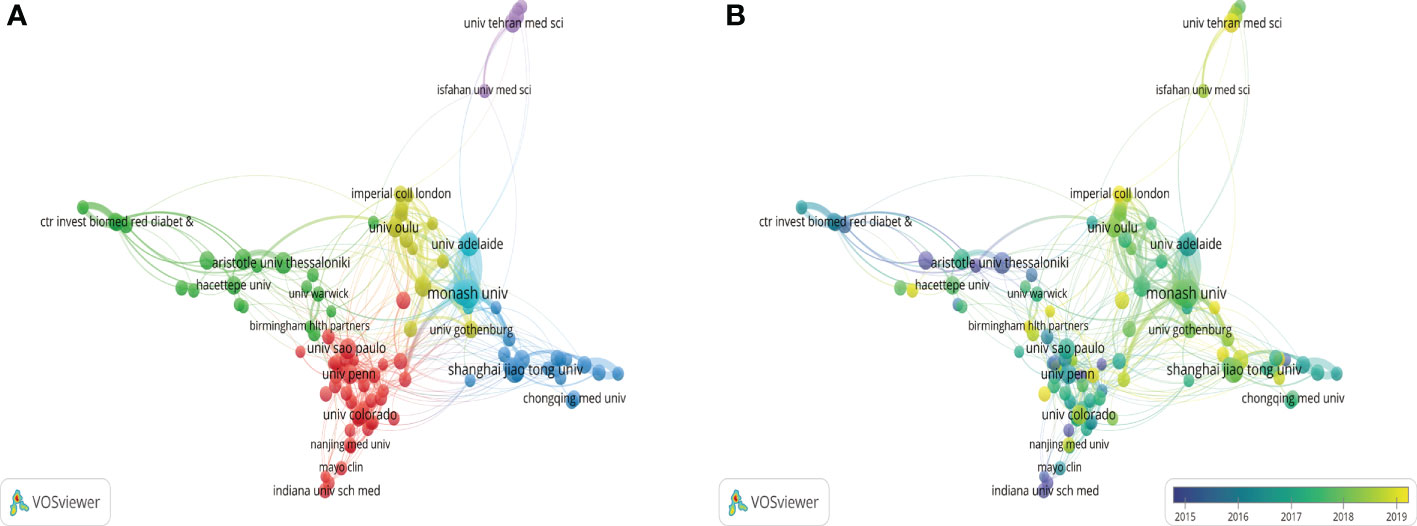
Figure 5 Visualization map of universities and institutions. (A) Network diagram of the top 100 universities/institutions. (B) Dynamics and trends of the top 100 universities/institutions.
3.5 Authors
Totally 12307 authors contributed to the publications in this domain. The author visualization map of the top 150 productive authors formed 10 clusters (Figure 6). The biggest cluster was Qiao Jie (34/12307), who came from Peking University. Stener-Victorin E (30/12307) had the second biggest cluster and was from Karolinska Institute. The third biggest cluster was Moran LJ (27/12307) who has published the most documents and collaborated with other researchers frequently (Figure 6 and Table 2).
3.6 Journals
This study showed that a total of 681 journals published records about obesity and PCOS. The results showed that the most productive journal was Gynecological Endocrinology (n=156), the most cited journal was The Journal of Clinical Endocrinology & Metabolism (4100 citation times), and the journal with the highest average citation was Endocrine Reviews (n=6, an average citation was 298.1 times). The top productive journals, top cited journals, and journals of top average citations were listed (n=10) in Supplement File 1.
3.7 Citations and co-citations
3.7.1 Top 10 citation publications
Of the 2843 records, the top 10 publications ranked by citation were listed in Table 3. The most cited article was published in Endocrine Reviews by Diamanti-Kandarakis E et al. in 2012 (23) and reported an update on mechanisms and implications of IR and PCOS with 874 citations, which was higher than that of the second paper (525 citations) (24). The third cited paper was on the pathogenesis of PCOS, with 454 citations (10).
3.7.2 Co-citation references
VOSviewer was used to visualize the co-citation network of references, which were divided into 3 clusters, with 93571 references (Figure 7). The larger node represents that the references are cited more frequently, and the line thickness represents the co-citation frequency. The top 10 co-cited references were shown in Table 4. And these co-citation papers were mainly published in Fertility and Sterility, The Journal of Clinical Endocrinology & Metabolism, and Human Reproduction.
3.8 Analysis of keywords
A total of 7462 keywords were extracted from the retrieved records. The network map of the top 100 keywords was grouped into 3 clusters (Figure 8A), and most of the top 10 keywords were clustered in the red cluster. The top 3 keywords were “obesity (n=1627)”, “polycystic ovary syndrome (n=1064)”, and “insulin-resistance (n=1037)”. From Figure 8B and Table 5, we can find that the hot research directions of obesity and PCOS in recent 10 years were insulin resistance, metabolic syndrome, metformin, inflammation, and so on.
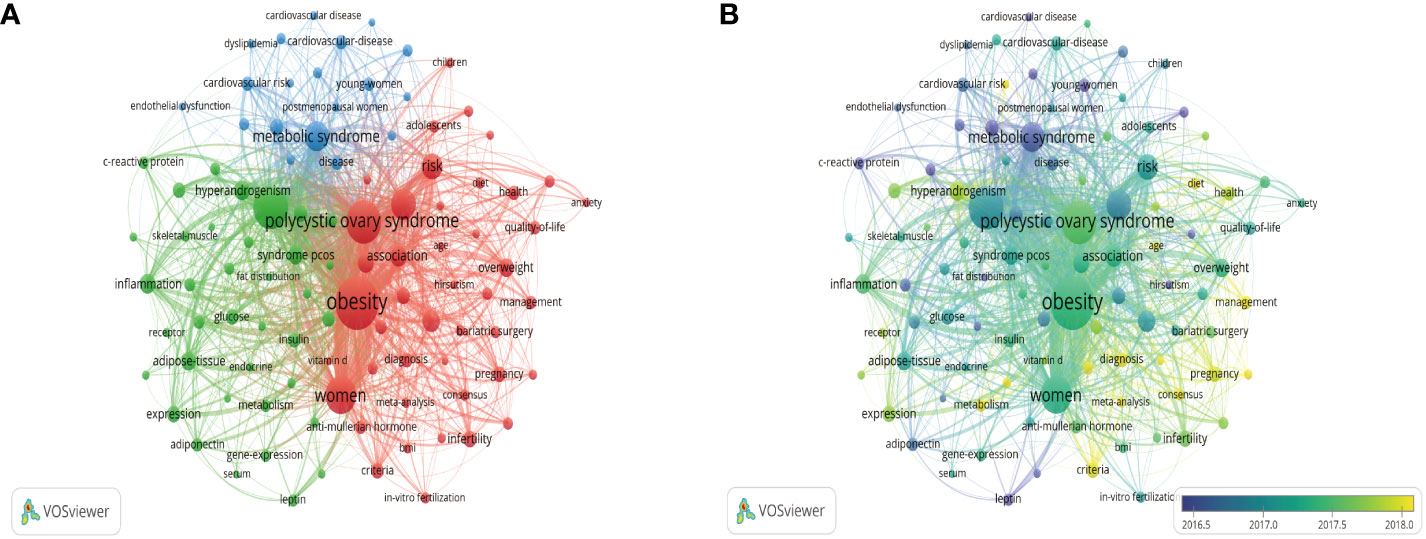
Figure 8 Visualization map of keywords. (A) Network diagram of the top 100 keywords. (B) Dynamics and trends of the top 100 keywords.
3.9 Research frontier analysis
By analyzing the keywords from 2021 to 2022, a keyword table of research frontiers was obtained (Table 6). According to the table, comorbidities of obesity and PCOS, mitochondrial dysfunction, binding globulin, and bariatric surgery may become the research frontier in the future.
4 Discussion
In contrast to traditional literature reviews, bibliometrics analysis can systematically analyze the published literature in a specific field (25). This study summarizes collaboration networks, research trends and hotspots, and future directions in obesity and PCOS based on bibliometric analysis. A total of 2843 records were retrieved and published in 681 journals by 12307 authors from 2942 institutes in 99 countries.
Based on our results, the number of published articles showed an increasing trend, especially in 2021, which indicated that this field had been a research hotspot, suggesting that novel researchers can engage in this research field. There is a correlation between academic productivity and socio-economic status for most countries (26). Ilagan-Vega et al. revealed that the research and development expenditures were significantly related to the academic impact of PCOS in Southeast Asia (17). In terms of article production, the United States ranked first, followed by China, Turkey, the United Kingdom, and Italy. Most of the top 5 countries with the most articles published were developed countries. The citation rate is an important index to measure the academic influence of a paper, which reflects the acceptance and recognition of a country’s scientific research achievements by other countries or institutions (27). The United States (n=23718) and the United Kingdom (n=7621) were the top 2 countries with the highest total citation frequency, but the average citation frequency in Australia was higher than these two countries, which indicated that Australia had greater influence in this field. It has been reported that international collaboration is a powerful factor in promoting academic productivity in a given field (28). In our analysis, different countries and regions had different degrees of cooperation, the United States, which published the most, showed the strongest links with China, followed by the United Kingdom. At the same time, these countries were also among the top 5 most prolific countries. Regional imbalances were observed in different districts and countries, and it was essential to strengthen collaboration and communication among developed and developing countries worldwide.
Meanwhile, the analysis of institutions and authors was similar to the distribution of countries and districts. Among 2942 institutions, Monash University and The University of Adelaide (Australia), Shanghai Jiao Tong University (China), Karolinska Institute, and Oulu University (European) made great contributions to this field and maintained a steady collaboration with other teams. In the last decade, Moran LJ, published the most articles, mainly focused on lifestyle intervention and metabolomics research in this direction (29–31). Qiao Jie, from Peking University, was in the biggest cluster and mainly focused on the pathogenesis and theoretical research in this area, such as immunity (32), gut microbiota (33), and single-cell sequencing (34).
Obesity and PCOS often interacted with each other and caused a significant risk to women’s health (5). Therefore, it received the attention and recognition of many journal editors. According to our results, hundreds of journals have published articles on this topic. Of 681 journals, the top 10 journals contributed the most. The most published journal was Gynecological Endocrinology, and the most cited journal was The Journal of Clinical Endocrinology & Metabolism, while Endocrine Reviews with the highest average paper citation. In addition, the top 3 most average cited journals in the included records were published in top-ranked journals, which indicated that these journals were widely recognized and deserved the attention of researchers in the field. These top-cited records, published in Endocrine Reviews, PloS One, Human Reproduction Update, and European Journal of Endocrinology, together had been cited more than 1853 times in the past 10 years. The common themes in this field’s top 10 cited research articles were the pathogenesis, epidemiology, diagnosis, and treatment of PCOS and its relationship to obesity. Co-citation analysis of references can tell researchers which references had made important contributions in this field. In co-citation analysis, “insulin resistance”, “mechanisms”, “implications”, and “criteria” were the keywords of the top co-citation references, which deserved reference for new researchers (23, 35, 36).
High-frequency keywords are usually used to identify research hotspots in a research field. Shi et al. revealed that the research trends of PCOS were gradually shifting from treatment to mechanistic exploration (18). According to the results of the keywords network map, we found that the research about obesity and PCOS mainly focused on insulin resistance, metabolic syndrome, drug therapy, and inflammation in recent years, which involved the mechanism, comorbidities, and treatment (37–39). It indicated that, in addition to mechanistic exploration, treatment was still a hot research topic in the field of obesity and PCOS.
The co-occurrence keyword analysis of the past 2 years revealed mechanisms, comorbidities, drug therapy, and bariatric surgery as emerging topics. Among obese girls with PCOS, mitochondrial acylcarnitine (C4) was associated with valine and free fatty acids (40). According to Fatemeh et al. (41), PCOS may reduce the occurrence of silent coronary artery disease in a population-based cohort study. Compared with metformin, bariatric surgery should be prioritized for patients with obesity and PCOS in a Chinese prospective nonrandomized trial (42). In these studies, researchers were able to identify the research hotspots, which may shape future research directions.
5 Limitations
Without a doubt, the study had several limitations. Firstly, we only analyzed records from the Web of Science Core Collection and only included English articles and reviews, which might lead to selection bias. However, the number of retrieved papers was large enough to reflect the real research situation (43). Secondly, due to the diversity of keywords and the authors with the same name, it was hard to accurately retrieve all the records.
6 Conclusions
Utilizing the retrieved records about obesity and PCOS, we performed a bibliometric and visual analysis. The number of papers published had roughly risen and extensive cooperation was observed between different countries and institutions. In this field, comorbidities, mitochondrial dysfunction, binding globulin, and bariatric surgery were the frontiers of research. Bibliometric analysis of the literature in this field was helpful for researchers to understand the collaboration patterns, research hotspots, and frontiers.
Data availability statement
The datasets presented in this study can be found in online repositories. The names of the repository/repositories and accession number(s) can be found in the article/Supplementary Material.
Author contributions
PL and JKL designed the study. PZL, GHW, SZ, WZL, ZW, XLS, ZBF, XHY, LYZ, and SHZ searched and analyzed the data. All the authors contributed to writing and approving the final manuscript.
Funding
This work was supported by the Wisdom Accumulation and Talent Cultivation Project of the Third Xiangya Hospital of Central South University (YX202102).
Acknowledgments
We thank professor Mingyi Zhao for Providing the methodology.
Conflict of interest
The authors declare that the research was conducted in the absence of any commercial or financial relationships that could be construed as a potential conflict of interest.
Publisher’s note
All claims expressed in this article are solely those of the authors and do not necessarily represent those of their affiliated organizations, or those of the publisher, the editors and the reviewers. Any product that may be evaluated in this article, or claim that may be made by its manufacturer, is not guaranteed or endorsed by the publisher.
Supplementary material
The Supplementary Material for this article can be found online at: https://www.frontiersin.org/articles/10.3389/fendo.2022.1011105/full#supplementary-material
References
1. Blüher M. Obesity: global epidemiology and pathogenesis. Nat Rev Endocrinol (2019) 15(5):288–98. doi: 10.1038/s41574-019-0176-8
2. Chooi YC, Ding C, Magkos F. The epidemiology of obesity. Metabolism (2019) 92:6–10. doi: 10.1016/j.metabol.2018.09.005
3. Piché ME, Tchernof A, Després JP. Obesity phenotypes, diabetes, and cardiovascular diseases. Circ Res (2020) 126(11):1477–500. doi: 10.1161/circresaha.120.316101
4. Powell-Wiley TM, Poirier P, Burke LE, Després JP, Gordon-Larsen P, Lavie CJ, et al. Obesity and cardiovascular disease: A scientific statement from the American heart association. Circulation (2021) 143(21):e984–e1010. doi: 10.1161/cir.0000000000000973
5. Escobar-Morreale HF. Polycystic ovary syndrome: definition, aetiology, diagnosis and treatment. Nat Rev Endocrinol (2018) 14(5):270–84. doi: 10.1038/nrendo.2018.24
6. Anonymous. Revised 2003 consensus on diagnostic criteria and long-term health risks related to polycystic ovary syndrome (PCOS). Hum Reprod (2004) 19(1):41–7. doi: 10.1093/humrep/deh098
7. Li R, Zhang Q, Yang D, Li S, Lu S, Wu X, et al. Prevalence of polycystic ovary syndrome in women in China: a large community-based study. Hum Reprod (2013) 28(9):2562–9. doi: 10.1093/humrep/det262
8. Bozdag G, Mumusoglu S, Zengin D, Karabulut E, Yildiz BO. The prevalence and phenotypic features of polycystic ovary syndrome: a systematic review and meta-analysis. Hum Reprod (2016) 31(12):2841–55. doi: 10.1093/humrep/dew218
9. Anagnostis P, Tarlatzis BC, Kauffman RP. Polycystic ovarian syndrome (PCOS): Long-term metabolic consequences. Metabolism (2018) 86:33–43. doi: 10.1016/j.metabol.2017.09.016
10. Rosenfield RL, Ehrmann DA. The pathogenesis of polycystic ovary syndrome (PCOS): The hypothesis of PCOS as functional ovarian hyperandrogenism revisited. Endocr Rev (2016) 37(5):467–520. doi: 10.1210/er.2015-1104
11. Legro RS. Obesity and PCOS: implications for diagnosis and treatment. Semin Reprod Med (2012) 30(6):496–506. doi: 10.1055/s-0032-1328878
12. Glueck CJ, Goldenberg N. Characteristics of obesity in polycystic ovary syndrome: Etiology, treatment, and genetics. Metabolism (2019) 92:108–20. doi: 10.1016/j.metabol.2018.11.002
13. Cincione RI, Losavio F, Ciolli F, Valenzano A, Cibelli G, Messina G, et al. Effects of mixed of a ketogenic diet in overweight and obese women with polycystic ovary syndrome. Int J Environ Res Public Health (2021) 18(23):12490. doi: 10.3390/ijerph182312490
14. Risal S, Pei Y, Lu H, Manti M, Fornes R, Pui HP, et al. Prenatal androgen exposure and transgenerational susceptibility to polycystic ovary syndrome. Nat Med (2019) 25(12):1894–904. doi: 10.1038/s41591-019-0666-1
15. Zhou L, Ni Z, Yu J, Cheng W, Cai Z, Yu C. Correlation between fecal metabolomics and gut microbiota in obesity and polycystic ovary syndrome. Front Endocrinol (Lausanne) (2020) 11:628. doi: 10.3389/fendo.2020.00628
16. Agarwal A, Durairajanayagam D, Tatagari S, Esteves SC, Harlev A, Henkel R, et al. Bibliometrics: tracking research impact by selecting the appropriate metrics. Asian J Androl (2016) 18(2):296–309. doi: 10.4103/1008-682x.171582
17. Ilagan-Vega MKC, Tantengco OAG, Paz-Pacheco E. A bibliometric analysis of polycystic ovary syndrome research in southeast Asia: Insights and implications. Diabetes Metab Syndr (2022) 16(2):102419. doi: 10.1016/j.dsx.2022.102419
18. Shi M, Huang W, Shu L, Hou G, Guan Y, Song G. Research on polycystic ovary syndrome: a bibliometric analysis from 2009 to 2019. Gynecol Endocrinol (2021) 37(2):121–25. doi: 10.1080/09513590.2020.1807501
19. Chen T, Yu Y, Jia F, Luan P, Liu X. The relationship between polycystic ovary syndrome and insulin resistance from 1983 to 2022: A bibliometric analysis. Front Public Health (2022) 10:960965. doi: 10.3389/fpubh.2022.960965
20. Zhuang S, Jing C, Yu L, Ji L, Liu W, Hu X. The relationship between polycystic ovary syndrome and infertility: a bibliometric analysis. Ann Transl Med (2022) 10(6):318. doi: 10.21037/atm-22-714
21. van Eck NJ, Waltman L. Software survey: VOSviewer, a computer program for bibliometric mapping. Scientometrics (2010) 84(2):523–38. doi: 10.1007/s11192-009-0146-3
22. van Eck NJ, Waltman L, Citation-based clustering of publications using CitNetExplorer and VOSviewer. Scientometrics (2017) 111(2):1053–70. doi: 10.1007/s11192-017-2300-7.
23. Diamanti-Kandarakis E, Dunaif A. Insulin resistance and the polycystic ovary syndrome revisited: an update on mechanisms and implications. Endocr Rev (2012) 33(6):981–1030. doi: 10.1210/er.2011-1034
24. Manikkam M, Tracey R, Guerrero-Bosagna C, Skinner MK. Plastics derived endocrine disruptors (BPA, DEHP and DBP) induce epigenetic transgenerational inheritance of obesity, reproductive disease and sperm epimutations. PloS One (2013) 8(1):e55387. doi: 10.1371/journal.pone.0055387
25. Kokol P, Blažun Vošner H, Završnik J. Application of bibliometrics in medicine: a historical bibliometrics analysis. Health Info Libr J (2021) 38(2):125–38. doi: 10.1111/hir.12295
26. Mariotto S, Mantovani A. Scientific productivity in neurology: impact of the socio-economic status. Neurol Sci (2021) 42(4):1563–66. doi: 10.1007/s10072-020-04893-6
27. Janssens A, Goodman M, Powell KR, Gwinn M. A critical evaluation of the algorithm behind the relative citation ratio (RCR). PloS Biol (2017) 15(10):e2002536. doi: 10.1371/journal.pbio.2002536
28. Wen P, Luo P, Zhang B, Zhang Y. Mapping knowledge structure and global research trends in gout: A bibliometric analysis from 2001 to 2021. Front Public Health (2022) 10:924676. doi: 10.3389/fpubh.2022.924676
29. Kazemi M, Kim JY, Wan C, Xiong JD, Michalak J, Xavier IB, et al. Comparison of dietary and physical activity behaviors in women with and without polycystic ovary syndrome: a systematic review and meta-analysis of 39 471 women. Hum Reprod Update (2022). doi: 10.1093/humupd/dmac023
30. Moran LJ, Mundra PA, Teede HJ, Meikle PJ. The association of the lipidomic profile with features of polycystic ovary syndrome. J Mol Endocrinol (2017) 59(1):93–104. doi: 10.1530/jme-17-0023
31. Teede HJ, Bailey C, Moran LJ, Bahri Khomami M, Enticott J, Ranasinha S, et al. Association of antenatal diet and physical activity-based interventions with gestational weight gain and pregnancy outcomes: A systematic review and meta-analysis. JAMA Intern Med (2022) 182(2):106–14. doi: 10.1001/jamainternmed.2021.6373
32. Huang N, Chi H, Qiao J. Role of regulatory T cells in regulating fetal-maternal immune tolerance in healthy pregnancies and reproductive diseases. Front Immunol (2020) 11:1023. doi: 10.3389/fimmu.2020.01023
33. Qi X, Yun C, Sun L, Xia J, Wu Q, Wang Y, et al. Gut microbiota-bile acid-interleukin-22 axis orchestrates polycystic ovary syndrome. Nat Med (2019) 25(8):1225–33. doi: 10.1038/s41591-019-0509-0
34. Li L, Dong J, Yan L, Yong J, Liu X, Hu Y, et al. Single-cell RNA-seq analysis maps development of human germline cells and gonadal niche interactions. Cell Stem Cell (2017) 20(6):858–73.e4. doi: 10.1016/j.stem.2017.03.007
35. Azziz R, Woods KS, Reyna R, Key TJ, Knochenhauer ES, Yildiz BO. The prevalence and features of the polycystic ovary syndrome in an unselected population. J Clin Endocrinol Metab (2004) 89(6):2745–9. doi: 10.1210/jc.2003-032046
36. Azziz R, Carmina E, Dewailly D, Diamanti-Kandarakis E, Escobar-Morreale HF, Futterweit W, et al. Positions statement: criteria for defining polycystic ovary syndrome as a predominantly hyperandrogenic syndrome: an androgen excess society guideline. J Clin Endocrinol Metab (2006) 91(11):4237–45. doi: 10.1210/jc.2006-0178
37. Dodd JM, Grivell RM, Deussen AR, Hague WM. Metformin for women who are overweight or obese during pregnancy for improving maternal and infant outcomes. Cochrane Database Syst Rev (2018) 7(7):Cd010564. doi: 10.1002/14651858.CD010564.pub2
38. Rohm TV, Meier DT, Olefsky JM, Donath MY. Inflammation in obesity, diabetes, and related disorders. Immunity (2022) 55(1):31–55. doi: 10.1016/j.immuni.2021.12.013
39. Wimalawansa SJ. Associations of vitamin d with insulin resistance, obesity, type 2 diabetes, and metabolic syndrome. J Steroid Biochem Mol Biol (2018) 175:177–89. doi: 10.1016/j.jsbmb.2016.09.017
40. Cree-Green M, Carreau AM, Rahat H, Garcia-Reyes Y, Bergman BC, Pyle L, et al. Amino acid and fatty acid metabolomic profile during fasting and hyperinsulinemia in girls with polycystic ovarian syndrome. Am J Physiol Endocrinol Metab (2019) 316(5):E707–e18. doi: 10.1152/ajpendo.00532.2018
41. Mahboobifard F, Rahmati M, Niknam A, Rojhani E, Momenan AA, Azizi F, et al. Impact of polycystic ovary syndrome on silent coronary artery disease and cardiovascular events; a long-term population-based cohort study. Arch Med Res (2022) 53(3):312–22. doi: 10.1016/j.arcmed.2021.11.001
42. Hu L, Ma L, Xia X, Ying T, Zhou M, Zou S, et al. Efficacy of bariatric surgery in the treatment of women with obesity and polycystic ovary syndrome. J Clin Endocrinol Metab (2022) 107(8):e3217–e29. doi: 10.1210/clinem/dgac294
Keywords: obesity, polycystic ovary syndrome, bibliometric analysis, visualization, VOSviewer
Citation: Luo P, Li J, Li P, Wang G, Li W, Song Z, Sun X, Fu Z, Zhou H, Yi X, Zhu L and Zhu S (2022) A bibliometric and visual analysis of obesity and polycystic ovary syndrome from 2012 to 2022. Front. Endocrinol. 13:1011105. doi: 10.3389/fendo.2022.1011105
Received: 03 August 2022; Accepted: 17 October 2022;
Published: 02 November 2022.
Edited by:
Zoltan Pataky, Hôpitaux universitaires de Genève (HUG), SwitzerlandReviewed by:
Ourlad Alzeus G. Tantengco, University of the Philippines Manila, PhilippinesYu Ligh Liou, The First Affiliated Hospital of Guangdong Pharmaceutical University, China
Cunchuan Wang, First Affiliated Hospital of Jinan University, China
Copyright © 2022 Luo, Li, Li, Wang, Li, Song, Sun, Fu, Zhou, Yi, Zhu and Zhu. This is an open-access article distributed under the terms of the Creative Commons Attribution License (CC BY). The use, distribution or reproduction in other forums is permitted, provided the original author(s) and the copyright owner(s) are credited and that the original publication in this journal is cited, in accordance with accepted academic practice. No use, distribution or reproduction is permitted which does not comply with these terms.
*Correspondence: Liyong Zhu, zly8128@126.com; Shaihong Zhu, shaihongzhu@126.com
†These authors have contributed equally to this work and share first authorship
 Ping Luo
Ping Luo